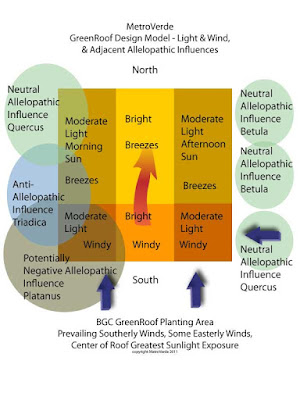- Light availability, and
- Wind Impacts.
Light and wind are the two most important design factors to consider when designing a green roof or living wall for hot and arid climates.
Without light, plants cannot complete the photosynthetic processes and will not survive. Even slight consistent wind impacts can evaporate water from the green roof or living wall plant leaf so rapidly the plant's vascular system cannot keep up, resulting in desiccation and death. Understanding light and wind levels are crucial to green roof design.
The Breaking Ground Contracting green roof planting area models light and wind as shown in the following illustration:
 |
| Light & Wind Model - Green Roof @ Breaking Ground Contracting |
Moving into the secondary design principles we look first to adjacent vegetation determining potential plant or tree allelopathic influences on the green roof as illustrated in the following.
 |
| Light & Wind Model - Green Roof @ Breaking Ground Contracting |
The Breaking Ground Contracting Green Roof is lined on the west, south and east sides by relatively mature trees, including the following genus';
- Quercus laurifolia, Laurel Oak - northwestern corner and eastern side of green roof
- Betula (River Birch) - eastern side of green roof
- Platanus occidentalis, American sycamore - southeastern and southwestern corners of green roof
- Triadica sebifera, Chinese tallow - western border of green roof
An alleopathic tree usually exerts negative influence on adjacent vegetation via a number of different processes including;
- Fog & dew drip
- Leaf litter
- Volatilization
- Sap drip
- Pollen, and
- Other biological processes
Looking at the individual adjacent trees, research data shows us;
- Quercus laurifolia, Laurel oak - although literature suggests laurel oak does not possess allelopathic qualities, care should be given to potential impacts of pollen and flower litter. The laurel oak adjacent the northwest corner of the green roof has stained the white TPO and covered the roofing material with a layer of leaf and pollen litter. Though laurel oak may not exhibit direct allelopathic influence on the green roof plants, potential for covering the plants with litter exists. Continued site inspection will be required to confirm any impacts on the green roof plantings.
- Triadica sebifera, Chinese tallow - one medium height tree exists adjacent the western border of the BGC green roof. Chinese tallow has been the subject of numerous allelopathic studies and research. Interestingly, research exists to support the theory of Chinese tallow leaf litter and fog drip may actually support germination and shoot growth on adjacent plants. In fact, Chinese tallow was shown to actually improve germination and growth rates in Little Bluestem, Schizachyrium
- Importantly, the American Sycamores, Platanus occidentalis located in the southeastern and southwestern corners of the BGC green roof have the potential to exert significant negative influence over the green roof plants. As indicated in the above list, American sycamore produces strong allelopathic effects. Data exists showing the active ingredients, scopoletin and chlorogenic acid found in the sycamore leaf may interfere with the ability of stomata on certain plant's leaves to malfunction, interrupting the vital processes of photosynthesis and either stunting plant growth or killing the plant. Close observation will be required on the effects of the American sycamore on the entire green roof planting area and in particular, the southeast and southwest corner plantings. Pruning of sycamore limbs away from the green roof may be necessary.
- Betula, river birch is not represented as allelopathic in the available research data.
Good green roof design incorporates the effects of adjacent trees and other vegetation and allelopathic effect possibilities. Recognizing and dealing with a potential allelopathic problem is much easier and more cost-effective up front. Know the basics of adjacent tree and plant allelopathism and how your green roof design integrates into a site with pre-existing trees.
No comments:
Post a Comment